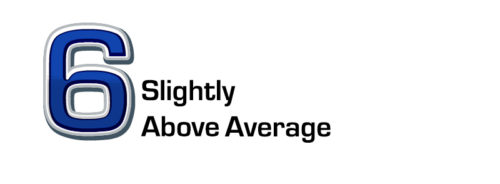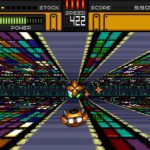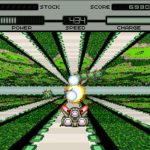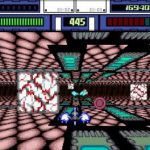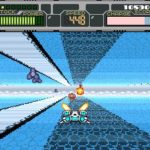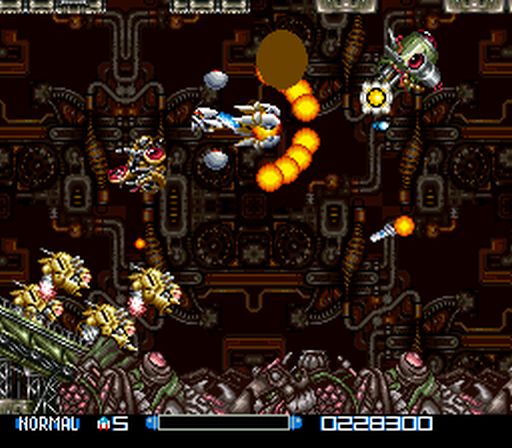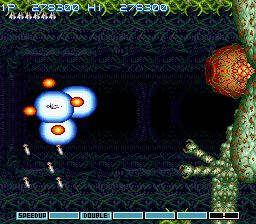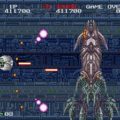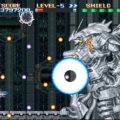Developer: HAL Publisher: HAL Release: 11/91 Genre: Action
Whenever a new console launches it is always interesting to see how developers will use the new technology. With the Wii waggle mechanics were tacked on to every game willy nilly. Early Xbox 360 titles looked like they were dipped in a vat of oil as developers wrestled with normal mapping. Possibly the most overused piece of technology was the SNES Mode 7. When used properly it introduced new experiences to many well-worn genres. Titles like Pilotwings and F-Zero really showed its potential. But for everyone of those there were plenty of titles that were gratuitous with its use for no reason. Did we really need to see Master Higgins swallowed by an overgrown pixelated whale? The answer is no. One oft forgotten SNES title is HyperZone. While it seems similar to F-Zero it is a shooter and a decent one at that but could have been better.
The comparison to F-Zero is unavoidable. HyperZone uses the SNES Mode 7 to present a sprawling track replete with detail. It goes a step further by mirroring the track on the ceiling as well. It looks weird at first but gives it a more complete look. The scaling is near perfect, with none of the heavy pixelation seen in other titles that used Mode 7 heavily. Each level is themed with your requisite ice, forest, and fire zones. But they also throw in a cityscape that is particularly striking. Although HyperZone is often forgotten it was an early SNES showcase. The soundtrack consists of pulsing techno that is decent but not memorable.
Although it looks like F-Zero it doesn’t play anything like it. The best way to describe is the mutant love child of Space Harrier and F-Zero. Beyond its surface appearance HyperZone sees your ship move along a track like Nintendo’s racer. The difference here is that you can move freely around the screen like Sega’s arcade classic. I say freely but in reality moving outside the track boundaries will incur damage. But you get the point.
Much like Space Harrier the object of the game is to keep moving and never stop. That is critical for a few reasons. Enemy waves are frequent, and they are usually aggressive in their attack. You can manually slow down, mainly to refill health in the pit stops but that makes you an easier target. More importantly losing too much speed reduces your health. You want to shoot down as many enemies as possible to rack up points in order to earn extra lives and more importantly new ships. At cetain point totals you earn a new ship. These ships come with a charge beam that either changes in size or charges faster as you progress. There are six in total and even with casual play most will earn the last by the end.
Since each level is thematic they come with new hazards and enemies to match. The blast furnace introduces pillars of flame alongside its fire themed enemies. The Old Capital has enemies that appear from behind and inflict massive damage. Aside from new enemies the track also evolves. The simple straight path begins to split, sometimes along three paths and even into a dead end. There isn’t always a connecting route to the other paths, forcing you to take a little damage to switch. There are many reasons to do so, namely to avoid enemies and possibly heal. But at its core HyperZone is a simple game which is its biggest flaw.
HyperZone is a fairly straightforward game and that is kind of the problem. The game is shallow; there are no other weapons aside from the charge shot and your regular attack. Even though there are six new ships you will barely notice any difference between them. The “track” design could also have been more interesting. Although you can move freely around the screen you are still on a path. When it branches and splits it becomes interesting. But these instances aren’t as common. You spend most of your time on a boring straight path.
The difficulty curve in HyperZone is exceedingly high. After the first two levels enemies routinely attack in swarms. The scaling makes it easier to judge distance but it is still easier to get pegged by enemy fire. Pit stops become less frequent, shorter, and even worse usually accompanied by a gang of enemies. Death comes frequently; by the midpoint four or five hits is all it takes. They award an extra life every 30,000 points but you won’t see it that often. Even worse than the lack of regular lives is no continues. There are eight levels, making this a medium length game. Its an incredibly bitter pill to swallow having to start from the beginning every time. Even limited continues would have been better.
In Closing
HyperZone starts out strong but peters out by the end. The simple gameplay will not hold your interest in the long run. Great production values cannot hide the fact that this is only a slightly above average game.
